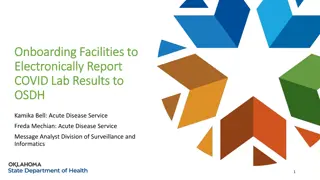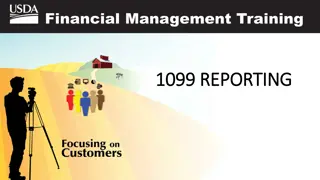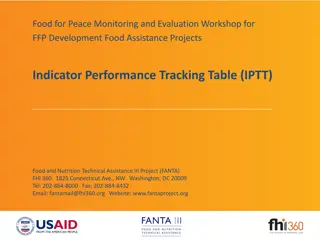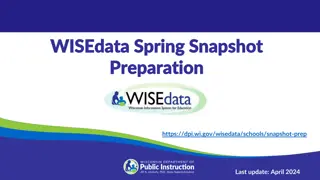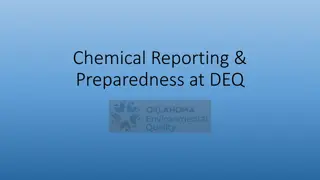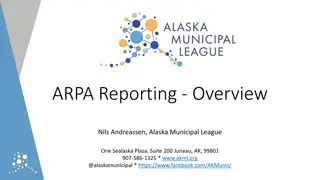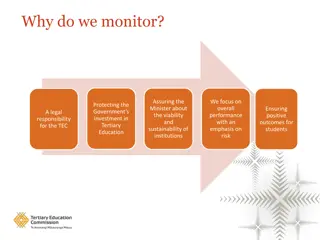Understanding IPTT for Effective Program Monitoring and Reporting
The Indicator Performance Tracking Table (IPTT) is a crucial tool for tracking performance indicators in food aid programs. It helps in linking objectives with baseline and target values, aiding in reporting, program improvement, and storytelling. This tool is utilized to fulfill reporting requirements, enhance program effectiveness, and communicate project outcomes effectively. Various group exercises are suggested to understand and utilize IPTT efficiently. The relationship between Result Framework (RF) and indicator levels is also explained for better comprehension.
Download Presentation

Please find below an Image/Link to download the presentation.
The content on the website is provided AS IS for your information and personal use only. It may not be sold, licensed, or shared on other websites without obtaining consent from the author. Download presentation by click this link. If you encounter any issues during the download, it is possible that the publisher has removed the file from their server.
E N D
Presentation Transcript
Indicator Performance Tracking Table (adapted from FANTA II) M&E Capacity Strengthening Workshop Addis Ababa 4 to 8 June 2012 Arif Rashid, TOPS
What is IPTT? The indicator performance tracking table (IPTT) includes performance indicators (at the impact, outcome and output levels) linked to the food aid program proposal s objectives, and baseline and target values for each indicator (estimated) Source: http://www.usaid.gov/our_work/humanitarian_assistance/ffp/ffpib_09.06.pdf Slide # 1
Purpose of IPTT Slide # 2
How will you use your IPTT? Slide # 3
How will you use IPTT? 15 minutes Identify two volunteers in your group. The first volunteer: take a copy of your IPTT and do the following: Choose one indicator and explain to your group how you will use it to report to Food for Peace. Choose a different indicator and explain how you will use it to improve your program. Choose a different indicator and explain how you will use it to tell your story (to tell other organizations, other funders, communities or beneficiaries about your project). The second volunteer should repeat the same. Slide # 4
How will you use IPTT? 15 minutes As a group, please select one section of your IPTT. Then look over each indicator in that section and LABEL each indicator as helping you to: Fulfill reporting requirements Improve your program Tell your story. NONE OF THE ABOVE. JUST LABEL, DON T MAKE REVISIONS YET Please take 15 minutes for this exercise. Slide # 5
How will you use IPTT? 15 minutes Tell your group members: One thing that you found out about indicators or your IPTT that you didn t know before. One thing you plan to do differently as a result of what you ve learned. Slide # 6
How are RF and Indicator levels related? Overarching Goal Impact Indicators/ Higher Outcome Indicators Strategic Objective 2 Strategic Objective 1 Medium/ Immediate Outcome Indicators Intermediate Result 2.1 Intermediate Result 1.1 Intermediate Result 1.2 Outputs Activities: a) b) c) Activities: a) b) c) Activities: a) b) c) Processes Inputs Slide # 7
Need indicator at every level Goal SO Farm incomes increased Production of non-traditional crops increased IR 20 Farmers planted the new crop and followed the intercultural practices learned from the project Project trained 50 farmers on non traditional crops, and distributed seeds and fertilizer Activities Slide # 8
Linking Indicators to RF Slide # 9
Develop Indicators at Each Level Activity assigned to your working group: Your Proposed Indicator Level of the Indicator (result) General Guideline The change in the condition or situation of the population Measures the highest level of change your project is responsible for bringing about Impact (SO level) Very often this is a behavior (acting, practicing) or knowledge change, but not always. There are higher and lower level outcomes, i.e. the higher level outcome could be increases in production while a lower level outcome would be the practices that a beneficiary uses. Outcome (IR level) Direct product of the implementer s activities Output (activity level) Slide # 10
IPTT Checklist Criteria What to ask yourself when developing or assessing your IPTT Slide # 11
What jobs can your indicator do? Does each indicator serve at least one of the following purposes: reporting, telling your story or improving your program? For example: does it provide other interesting information i.e. information that indicates whether the food security situation is improving? whether communities and beneficiaries are making progress? how well we are doing in implementing? Slide # 12
Does each indicator measure a specific result? Overarching Goal Impact Indicators/ Higher Outcome Indicators Strategic Objective 2 Strategic Objective 1 Medium/ Immediate Outcome Indicators Intermediate Result 2.1 Intermediate Result 1.1 Intermediate Result 1.2 Outputs Activities: a) b) c) Activities: a) b) c) Activities: a) b) c) Processes Inputs Slide # 13
IPTT Checklist Criteria Is each indicator precise and well defined enough to give the reader a clear idea of what is being measured? Slide # 14
IPTT Checklist Criteria Is it FEASIBLE to collect and analyze the data for each indicator? Slide # 15
IPTT Checklist Criteria Is it FEASIBLE to collect and analyze the data for each indicator? Slide # 16
IPTT Checklist Criteria Is it FEASIBLE to collect and analyze the data for each indicator? An IPTT should not have too MANY or too FEW indicators. A BALANCED set of indicators that captures all three aspects reporting, telling your story and improving program management is expected. Slide # 17
IPTT Checklist Criteria Does the IPTT include gender- sensitive indicators appropriate to your RF? Slide # 18
IPTT Checklist PROGRAM GOAL: Reduce Food Insecurity of Vulnerable Populations in Western Province SO 1: Improved livelihood capacities of vulnerable households Impact 1.1 Average Household Dietary Diversity Score (FFP) Outcome 1.2 Percent of trained beneficiaries scoring 70% or above on post-test scores (+) (+) Slide # 19
IPTT Checklist PROGRAM GOAL: Reduce Food Insecurity of Vulnerable Populations in Western Province SO 1: Improved livelihood capacities of vulnerable households (+) Impact 1.1 Average Household Dietary Diversity Score (FFP) (+) 1.2 Percentage of households with access to an improved sanitation facility Outcome Slide # 20
IPTT Checklist Criteria Is each target reasonable? Can you reasonably expect to reach the target? Is it ambitious enough to make a difference to your beneficiaries? Can you justify your targets? For example is the target based on your organization s past experience with a Title II program or another similar program? Slide # 21
IPTT Checklist Slide # 22
This presentation was made possible by the generous support of the American people through the United States Agency for International Development (USAID). The contents are the responsibility of Save the Children and do not necessarily reflect the views of USAID or the United States Government.




